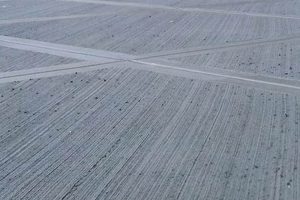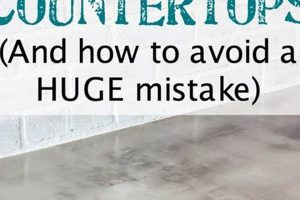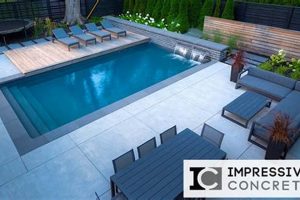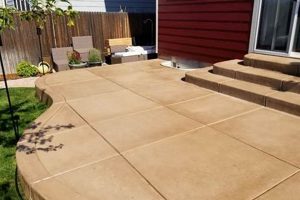Interior application of surface treatments to cementitious materials transforms utilitarian slabs into aesthetically pleasing design elements. These treatments can encompass a variety of techniques, including polishing, staining, sealing, and overlaying, all performed within the confines of a building’s interior. As an example, a ground-level apartment might feature a polished floor, showcasing its aggregate and finished with a protective sealant to enhance its durability and appearance.
The utilization of these modified surfaces offers several advantages. These include enhanced durability, design flexibility, and potential for improved indoor air quality when sealed properly. Furthermore, the material possesses inherent thermal mass properties, contributing to energy efficiency. Historically, its application was primarily functional, but contemporary architectural design recognizes its potential for adding a unique and modern aesthetic to living and working spaces.
The subsequent sections of this discussion will explore specific types of surface modifications, application methods, maintenance considerations, and the environmental impact associated with these choices. Each aspect plays a critical role in achieving the desired outcome and ensuring the longevity of the treated surface.
Guidance for Interior Cementitious Surface Treatments
Careful consideration during the application and maintenance of interior cementitious surface treatments is essential for optimal performance and aesthetic outcome. The following guidelines offer insights into key aspects of the process.
Tip 1: Surface Preparation is Paramount: Ensure the substrate is clean, dry, and free of any contaminants, such as dust, grease, or existing coatings. Inadequate preparation will compromise the adhesion and longevity of the selected finish.
Tip 2: Consider Substrate Conditions: Analyze the existing slab for cracks, unevenness, or moisture content. Address any deficiencies prior to applying the finishing material to prevent future issues.
Tip 3: Select Appropriate Finishing Materials: Choose sealers, stains, and overlays that are specifically designed for interior use and compatible with the existing slab. Consider factors such as VOC content, durability, and desired aesthetic.
Tip 4: Control Environmental Conditions: Maintain consistent temperature and humidity levels during application and curing. Fluctuations can negatively impact the setting and adhesion of the finish.
Tip 5: Apply Thin, Even Coats: When using coatings or overlays, apply multiple thin coats rather than a single thick coat. This minimizes the risk of cracking, bubbling, or uneven curing.
Tip 6: Proper Curing is Crucial: Adhere to the manufacturer’s recommended curing times for each material. Premature use of the treated surface can result in damage and compromised performance.
Tip 7: Regular Maintenance is Essential: Implement a consistent cleaning schedule using pH-neutral cleaners. Avoid harsh chemicals or abrasive tools that can damage the finish.
These recommendations emphasize the importance of meticulous preparation, appropriate material selection, controlled application, and consistent maintenance in achieving successful and durable outcomes. Adherence to these guidelines will contribute to the longevity and aesthetic appeal of the interior cementitious surfaces.
The subsequent sections will delve into specific examples of interior cementitious surface treatment applications.
1. Aesthetics
Aesthetics play a pivotal role in the specification and implementation of interior cementitious surface treatments. Beyond mere functionality, the visual and tactile qualities of these surfaces significantly contribute to the overall ambiance and design intent of interior spaces. The selected finish directly influences the perception of the space, impacting its perceived value and user experience.
- Color and Tone
The choice of color, whether achieved through integral pigments, stains, or overlays, establishes the mood of the space. Light hues tend to create an open and airy feel, while darker tones evoke a sense of intimacy and sophistication. Polished gray installations in commercial spaces lend a modern, industrial feel, and the selection of a color should complement other design elements present.
- Texture and Pattern
The texture of the surface, ranging from smooth and polished to rough and exposed aggregate, adds another layer of visual and tactile interest. Embossed patterns or decorative scoring can further enhance the aesthetic appeal, creating unique and personalized finishes. A subtly textured, troweled surface in a residential living room, for example, can add depth and character.
- Sheen and Reflectivity
The level of sheen, ranging from matte to high-gloss, affects how light interacts with the surface. High-gloss finishes amplify light and create a sense of spaciousness, while matte finishes offer a more subdued and natural look. A high-gloss finish may be favored in retail settings to enhance product visibility, while a matte finish may be preferred in a gallery setting to minimize glare and distraction.
- Aggregate Exposure
In some applications, the aggregate within the slab is intentionally exposed through grinding and polishing. This reveals the natural beauty of the stone and creates a unique, terrazzo-like effect. The size, color, and distribution of the aggregate contribute to the overall aesthetic, adding visual complexity and depth.
Ultimately, the selection of a particular interior cementitious surface treatment involves a careful balancing of functional requirements and aesthetic goals. Consideration of color, texture, sheen, and aggregate exposure allows designers to create spaces that are both visually appealing and functionally appropriate, leveraging the versatility of concrete as a design medium.
2. Durability
The longevity and performance of interior cementitious surface treatments are intrinsically linked to their durability. The inherent properties of the slab, coupled with the selected finish, determine its resistance to wear, impact, staining, and other forms of degradation. A failure to adequately address durability concerns can result in costly repairs, diminished aesthetic appeal, and a shortened lifespan for the surface treatment. Consider, for instance, the flooring of a high-traffic retail space. A properly sealed and hardened surface will withstand the constant abrasion from foot traffic and the potential for spills, whereas an untreated or poorly protected slab is susceptible to staining, scratching, and eventual deterioration.
The selection of finishing materials and application techniques directly influences the durability of the treated surface. Epoxy coatings, for example, offer superior resistance to chemicals and abrasion compared to acrylic sealers, making them suitable for environments such as commercial kitchens or laboratories. Similarly, penetrating sealers that chemically react with the substrate to create a hardened surface provide greater protection against wear than film-forming sealers that are merely applied to the surface. The correct application procedure, including proper surface preparation and curing times, is also crucial for maximizing the durability of the selected finish. A failure to properly prepare the slab, such as leaving residual dust or debris, can compromise the adhesion of the finish and lead to premature failure.
In summary, durability is a critical factor in the successful application of interior cementitious surface treatments. Careful consideration must be given to the expected traffic, potential for spills or impacts, and the specific environmental conditions to which the surface will be exposed. By selecting appropriate finishing materials, employing proper application techniques, and implementing a regular maintenance schedule, the longevity and aesthetic appeal of interior cementitious surfaces can be significantly enhanced. Addressing potential durability issues proactively ensures a long-term investment in the interior environment.
3. Application methods
The successful implementation of interior cementitious surface treatments is inextricably linked to the employed application methods. The choice of technique significantly influences the final aesthetic, durability, and overall performance of the modified surface. Improper application can lead to a range of undesirable outcomes, including aesthetic flaws, compromised structural integrity, and a reduction in the lifespan of the finish. For example, the polishing of a floor requires specialized equipment and a multi-stage process involving progressively finer grits of abrasive pads. A failure to adhere to proper grinding and polishing protocols can result in uneven surfaces, visible scratches, and a lack of the desired sheen. Similarly, the application of epoxy coatings necessitates precise mixing ratios and environmental controls to ensure proper curing and adhesion.
Specific examples further highlight the criticality of suitable application methods. Staining, a technique used to impart color, requires even distribution and precise dwell times to achieve consistent color saturation. Inadequate surface preparation prior to staining can lead to blotchy or uneven coloration. Overlay systems, designed to resurface or level existing slabs, demand meticulous mixing and pouring techniques to prevent air entrapment and cracking. Moreover, the method of sealing plays a vital role in protecting the surface from stains and moisture penetration; the chosen sealer must be applied according to manufacturer specifications, ensuring complete and uniform coverage.
In conclusion, the selection and execution of appropriate application methods represent a cornerstone of interior cementitious surface treatments. Thorough knowledge of material properties, surface preparation requirements, and proper application techniques is essential for achieving durable and aesthetically pleasing results. A commitment to best practices ensures that the intended benefits of the selected finish are fully realized, maximizing both the functional and aesthetic value of the interior space.
4. Maintenance
The sustained aesthetic appeal and functional longevity of interior cementitious surface treatments are directly contingent upon diligent maintenance practices. The absence of a consistent maintenance regimen invariably leads to premature degradation of the finish, necessitating costly repairs or complete replacement. The causal relationship between neglect and deterioration is undeniable. For example, a polished floor in a commercial setting, subjected to heavy foot traffic and potential spills, requires regular cleaning with pH-neutral solutions to prevent the accumulation of dirt, grime, and abrasive particles that can dull the surface and cause scratches. A failure to implement such a cleaning schedule results in a gradual loss of luster and an increased susceptibility to staining.
Furthermore, the specific type of surface treatment dictates the required maintenance protocols. A sealed surface, designed to repel liquids and prevent staining, necessitates periodic reapplication of the sealant to maintain its protective properties. The frequency of reapplication depends on the type of sealer used and the level of traffic to which the surface is exposed. In contrast, an exposed aggregate surface, while inherently durable, may require occasional scrubbing with a brush and mild detergent to remove ingrained dirt and maintain its textured appearance. Neglecting these specific maintenance requirements undermines the intended benefits of the chosen finish and accelerates its deterioration.
In conclusion, effective maintenance is not merely an ancillary consideration, but an integral component of interior cementitious surface treatments. A proactive approach to cleaning, sealing, and addressing minor damage is essential for preserving the aesthetic appeal, extending the lifespan, and maximizing the return on investment in these surface finishes. Understanding the specific maintenance requirements of each type of finish and implementing a consistent schedule ensures the long-term performance and visual integrity of interior surfaces.
5. Cost considerations
The implementation of surface treatments on interior cementitious materials inherently involves multifaceted cost considerations. The selection of a particular finish directly influences material expenses, labor requirements, and long-term maintenance budgets. An initial underestimation of these costs can lead to project overruns and compromises in the final product. As a direct example, the choice between a simple, sealed surface and a highly polished, multi-stage process results in significantly different expenditure levels. Polishing necessitates specialized equipment, trained technicians, and multiple passes to achieve the desired sheen, substantially increasing labor costs compared to the relatively straightforward application of a sealant. Similarly, the incorporation of decorative aggregates or intricate staining patterns adds complexity and expense to the project.
Further analysis reveals that cost considerations extend beyond the initial installation phase. The long-term maintenance requirements associated with each finish play a crucial role in the overall lifecycle cost. While a durable epoxy coating may have a higher upfront expense, its resistance to wear and staining can minimize the need for frequent repairs or replacements, potentially resulting in long-term savings. Conversely, a less expensive acrylic sealer may require more frequent reapplication, incurring ongoing material and labor costs. The environmental impact of the chosen materials also factors into cost considerations, as environmentally friendly options may command a premium price but offer benefits in terms of regulatory compliance and potential tax incentives.
In summary, a comprehensive understanding of cost considerations is paramount to the successful application of surface treatments on interior cementitious slabs. A thorough evaluation of material costs, labor requirements, maintenance budgets, and environmental factors ensures that project goals are achieved within budgetary constraints and that the selected finish delivers long-term value. A failure to adequately address these considerations can result in financial setbacks and compromised outcomes, underscoring the critical importance of informed decision-making throughout the project lifecycle.
6. Environmental impact
The application of surface treatments to interior cementitious materials carries inherent environmental consequences that demand careful consideration. The manufacturing processes of these treatments, including sealers, coatings, and stains, often involve the consumption of energy and resources, as well as the generation of waste products and emissions. Furthermore, the volatile organic compounds (VOCs) released from certain finishes can negatively impact indoor air quality and contribute to atmospheric pollution. For example, solvent-based sealers typically contain high levels of VOCs, leading to potential health concerns for occupants and contributing to smog formation. Conversely, water-based or low-VOC alternatives offer a more environmentally responsible option, minimizing emissions and improving indoor air quality. The selection of finishes must therefore balance performance characteristics with environmental responsibility.
Beyond the direct impacts of material production and application, the long-term performance of these surface treatments also influences environmental sustainability. Durable finishes that resist wear and degradation reduce the need for frequent replacements, thereby minimizing resource consumption and waste generation. The proper disposal of used materials and containers also presents a significant environmental challenge. Improper disposal can lead to soil and water contamination, underscoring the importance of adhering to responsible waste management practices. For instance, the recycling of concrete debris and the proper disposal of leftover coatings can significantly reduce the environmental footprint of interior surface treatments. The life cycle assessment of different finishes provides a valuable framework for evaluating their overall environmental performance, considering factors such as embodied energy, greenhouse gas emissions, and waste generation.
In summary, the environmental impact of interior cementitious surface treatments represents a critical consideration that encompasses material selection, application practices, and waste management. A commitment to sustainable practices, including the use of low-VOC materials, responsible disposal methods, and life cycle assessment, is essential for minimizing the environmental footprint of these finishes. Balancing performance requirements with environmental responsibility ensures that interior spaces are not only aesthetically pleasing and functional but also contribute to a healthier and more sustainable environment. Future innovations in material science and application techniques offer the potential for further reducing the environmental burdens associated with interior cementitious surfaces.
7. Surface Preparation
The successful execution of any interior cementitious surface treatment is predicated upon meticulous surface preparation. This preliminary stage directly influences the adhesion, durability, and aesthetic outcome of the applied finish. Inadequate preparation invariably leads to compromised performance, regardless of the quality of the chosen materials. For example, the application of a self-leveling overlay over a substrate contaminated with residual adhesives will likely result in delamination, cracking, and a compromised finished surface. Therefore, surface preparation functions as a critical enabling step in the broader process of finishing interior concrete.
The specific requirements for surface preparation vary depending on the type of finish being applied and the condition of the existing concrete slab. Generally, the process involves removing existing coatings, cleaning the surface to eliminate dust, grease, and other contaminants, and addressing any cracks or imperfections. Mechanical methods, such as grinding, shot blasting, or scarifying, are commonly employed to achieve a clean and properly profiled surface. The profiling creates a mechanical key, enhancing the bond between the concrete and the applied finish. Consider the application of a polished concrete floor. The initial grinding stages not only remove existing imperfections but also expose the aggregate, creating the desired aesthetic effect. Without this initial grinding, the subsequent polishing steps would be ineffective in achieving the desired result.
In conclusion, surface preparation is not merely a preliminary task but an essential component of interior cementitious surface treatments. Its meticulous execution ensures optimal adhesion, durability, and aesthetic appeal, maximizing the lifespan and performance of the finished surface. Neglecting this critical step inevitably leads to compromised results, underscoring its fundamental importance in achieving successful and long-lasting interior surfaces. A thorough understanding of surface preparation techniques and their impact on the final outcome is paramount for anyone involved in specifying or applying these treatments.
Frequently Asked Questions
This section addresses common inquiries regarding the selection, application, and maintenance of interior cementitious surface treatments, providing concise and informative answers based on industry best practices.
Question 1: What factors determine the suitability of a particular interior cementitious surface treatment for a given space?
Traffic volume, intended use of the space, aesthetic preferences, and budgetary constraints are critical determinants. Additionally, consideration must be given to the existing slab’s condition and the compatibility of the selected finish with the substrate.
Question 2: How can the environmental impact of interior cementitious surface treatments be minimized?
Selecting low-VOC materials, employing responsible waste disposal practices, and prioritizing durable finishes that reduce the need for frequent replacements are key strategies. Life cycle assessments can aid in evaluating the overall environmental performance of different options.
Question 3: What are the essential steps in surface preparation for interior cementitious surface treatments?
Surface preparation typically involves removing existing coatings, cleaning the surface to eliminate contaminants, repairing cracks or imperfections, and profiling the slab to enhance adhesion. The specific steps will vary depending on the condition of the existing substrate.
Question 4: How does maintenance differ among various types of interior cementitious surface treatments?
Maintenance requirements vary depending on the finish. Sealed surfaces require periodic reapplication of the sealant, while polished surfaces necessitate regular cleaning with pH-neutral solutions. Exposed aggregate surfaces may require occasional scrubbing to remove ingrained dirt.
Question 5: What are the typical cost components associated with interior cementitious surface treatments?
Cost components include material expenses, labor requirements, equipment rental, surface preparation, and ongoing maintenance. The specific costs will vary depending on the complexity of the finish and the size of the project.
Question 6: How can the durability of an interior cementitious surface treatment be maximized?
Selecting appropriate finishing materials for the intended use, employing proper application techniques, ensuring thorough curing, and implementing a consistent maintenance schedule are crucial for maximizing durability.
These FAQs provide a foundational understanding of the key considerations involved in interior cementitious surface treatments. Informed decision-making is essential for achieving successful and long-lasting results.
The subsequent sections will delve into case studies and practical examples of diverse projects featuring the application of surface treatments on interior cementitious materials.
Conclusion
The preceding exploration elucidates the multifaceted nature of concrete finishes indoor. It highlights the critical interplay between aesthetic considerations, durability requirements, application methods, maintenance protocols, cost implications, environmental impact, and surface preparation. A comprehensive understanding of these interdependencies is essential for achieving successful and sustainable interior environments utilizing cementitious materials.
The informed application of surface treatments on interior concrete represents a significant opportunity to enhance both the functional performance and aesthetic appeal of built spaces. Continued research and development in material science and application techniques will undoubtedly further expand the possibilities for innovative and sustainable concrete finishes indoor, shaping the future of interior design and construction.


![Concrete Finishes: Types, Cost, Application [Guide] Best Final Touch: Elevate Your Projects with Professional Finishing Concrete Finishes: Types, Cost, Application [Guide] | Best Final Touch: Elevate Your Projects with Professional Finishing](https://bestfinaltouch.com/wp-content/uploads/2025/12/th-566-300x200.jpg)




